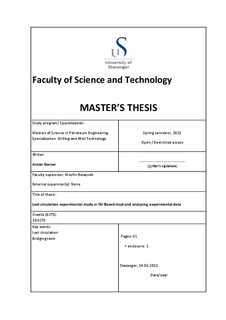| dc.description.abstract | The problem of lost circulation have for a long time occurred during the drilling operation. During the drilling through induced and natural fractures, huge drilling fluid losses lead to the higher operational expenses. That is why, it is vital to design the drilling fluid, so that it may minimize the mud invasion in to formation and prevent lost circulation.
Generally, the mud loss occurs in the cavernous and vugular formations, as well as naturally occurring or induced fractures, or fractures in permeable and low permeability formations. Historically, this problem was dealt with the help of the Lost Circulation Materials (LCM). These materials are added to the drilling fluid to seal the fractures and to increase fracture initiation or fracture propagation pressure. The lost circulation materials may be used in the form of pills, when the lost circulation zone is identified. In some cases, solutions to lost circulation may be obtained by the pretreatment of the drilling mud with the particles of the proper material and with the proper particle size distribution. Subsequent treatment is also important, as a form of lost circulation prevention, when the particles are efficiently added to the mud system in the correct size, shape and type. Understanding the mechanisms of fracture sealing and the performance of the lost circulation materials is critical if the problem of lost circulation is to be mitigated effectively.
The objective of this thesis was to investigate the performance of the chosen lost circulation materials (i.e LC-Lube) in 60/40 and 80/20 oil/water ratio OBM mud systems. The bridging performance of LC-Lube was studied with the help of the bridging tests in the laboratory. The D50 of the particle size distribution was 310 μm. The slot openings used in the bridging tests were 100 μm, 250μm, 300 μm, 400 μm and 500 μm. The concentration of LC-lube additive were 16,85 lb/bbl and 8,49 lb/bbl. The results of the tests were compared and the performance of the bridging materials discussed and analyzed. The results have shown that the LCM performance in two different mud systems when it comes to bridging, was better with 60/40 OBM in the case of 250 μm and 300 μm slot openings and a concentration of 16,85 lb/bbl. In the case of a lower concentration of the LC-lube, the performance with the 60/40 was as well better with the slot openings of 250 μm and 300 μm, although the difference was less pronounced. | no_NO |
